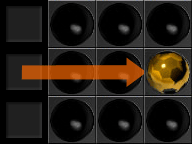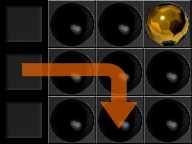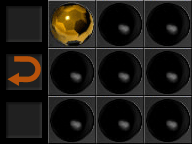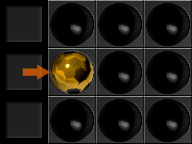BLACKBOX
The ultimate game of hide and seek
Player's Guide
Introduction
BlackBox™ is a Parker Brothers (now owned by Hasbro) game, introduced in the late 1970s in which the player must deduce the location of hidden elements within a black box by applying inputs and observing the behavior of the outputs.
In the game, 3 to 5 balls (depending on how many the player chooses when starting the game) are hidden in an 8-by-8 grid. Inputs are supplied in the form of rays that the player shoots into the sides of the grid. Because these rays behave according to deterministic rules when in the vicinity of a ball within the grid, the locations of the balls can be deduced by observing the input and output characteristics of the rays.
The object of the game is to accurately guess the location of the hidden balls using the least amount of information.
Shooting Rays
This result will be one of the following:
Detour markers are always placed in pairs using matching symbols.
Additionally, it should be noted that (because of the way that rays behave) entry and exit points are commutative. If a ray shot into one port exits at a second, a ray shot into the second port would have emerged at the first.
Ray Behavior Rules
Rays behave using a simple set of ironclad rules. By logically applying these rules, the player must deduce the location of the hidden balls by observing the entry and exit behavior of the rays. The player cannotsee what the rays do inside the grid — that's the intrinsic concept of a black box. The observed input/output behaviors must be used to deduce the internal action of the rays, and subsequently the location of the hidden balls.
The rules are presented below in order of strongest to weakest. In other words, Rule 1 takes precedence over Rule 2 and so on.
Rule 1: When no balls are in the vicinity, a ray will simply travel in a straight line. So if there are no balls along its path, a ray will simply travel straight through the grid and come out directly on the other side.

Rule 2: If a ray hits a ball straight on, it is absorbed by the ball and disappears. It will never exit the grid.

Rule 3: A ray cannot pass by a ball on its left or right. When a ray detects a ball that is one grid cell ahead and to the left or right, it will be deflected away from the ball at a right angle. Note that the deflection occurs before the ray comes up to the side of the ball. This distinction is what trips up most novice players.
Carefully observe the behavior in the diagram below; this is likely the most important concept that can be taken away from this guide.

Rule 4: If a ray encounters two balls, one ahead and to the left, and one ahead and to the right, it does an about face and makes a 180° turn back the way it came.
This behavior makes perfect sense, and is, in essence, a special case of Rule 3. The ball on the left turns the ray to the right, in which case the second ball, which is now to the turned ray's left, causes another turn to the right. This results in a complete 180° turn.

Rule 5: If a ball at the edge of the grid is to the ray's right or left, it prevents the ray from even entering the grid, and the ray appears to exit the grid at the entry port, resulting in a reflection.

Note that if there is a ball at the edge of the grid directly ahead of the ray, Rule 2 takes precedence regardless of the absence or presence of balls to the left or right, and the result is a hit. Both situations diagrammed below result in a hit.


Rule 2 always supersedes Rules 3 and 4, so if a ball is directly ahead of a ray, the result is always a hit.
Placing Guesses
Guesses are recorded by clicking on the cells within the grid. Clicking on an empty cell places a guess in that cell, indicated with a gold ball. Clicking on an occupied cell removes that guess.
Guesses can be freely placed and removed as many times as the player would like without penalty. There is no down-side to making, removing, or moving guesses around. In fact, it's an important part of visualizing the final solution.
Only as many guesses as there are balls hidden within the grid can be placed. So in a 4-ball game, up to 4 guesses can be placed. To move a guess, an existing guess must be removed before clicking on an empty cell to place a new guess.
Once the full number of guesses have been placed (3, 4 or 5 depending upon how many balls are selected at game start), these guesses can be submitted by clicking the Submit Guesses button.
This concludes the game and the results and final score are displayed.
Scoring
The final score is the summation of the amount of information needed to solve the puzzle, along with the accuracy of the guesses.
Lower scores are obviously better, and the numeric score value is computed as follows:
- One point for every hit.
- One point for every reflection.
- Two points for every detour.
- Five penalty points for every ball that is guessed incorrectly.
When the game is complete, the final score and how it was obtained is displayed in the control panel area, and the grid is updated to show the correct and incorrect guesses, as well as the actual locations of the balls.
Other Information
A new game can be started at any time by clicking the Restart button. If the current game is incomplete, the player will be prompted to confirm abandoning the running game.
Games can be bookmarked in the browser at any time, and returned to at a later date to resume playing the game.
All rights reserved
BlackBox™ is a registered trademark of Parker Brothers Games